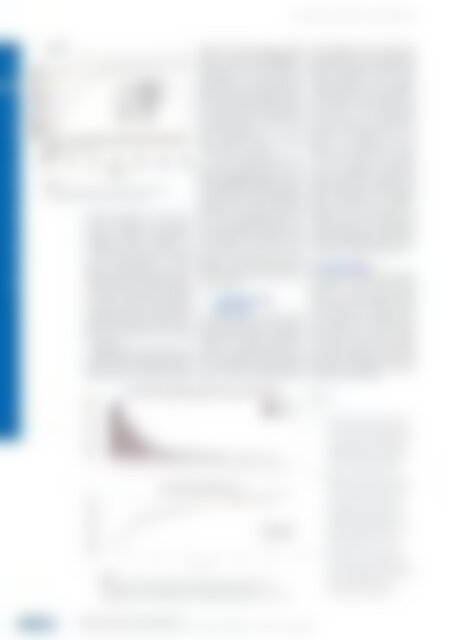Create successful ePaper yourself
Turn your PDF publications into a flip-book with our unique Google optimized e-Paper software.
<strong>atw</strong> Vol. 63 (<strong>2018</strong>) | Issue 8/9 ı August/September<br />
472<br />
AMNT <strong>2018</strong> | YOUNG SCIENTISTS' WORKSHOP<br />
| | Fig. 8.<br />
Time resolved washed off mass for different wash-off coefficients.<br />
Parameters according to Table 1 and ρ p = 5000 kg/m 2 .<br />
transport simulations last for 30 s.<br />
First the influence of the Weber<br />
number is investigated, see Figure 6.<br />
Increasing Weber numbers correspond<br />
to larger water velocities and<br />
an increasing percentage of wetted<br />
surface. Consequently for larger<br />
Weber numbers more particle mass is<br />
washed off. Thus two effects manifest<br />
in the results: first the larger velocities<br />
are able to wash-off even particles<br />
with larger density. And secondly the<br />
enlarged percentage of wetted surface<br />
enhances the particle wash-off, since<br />
much more particles can be eroded<br />
by the water.<br />
Figure 7 shows the variation of the<br />
particle density. Particles with larger<br />
density cannot be eroded that easily<br />
and hence the total washed off mass<br />
decreases with increasing particle<br />
density, as expected. In Figure 8 the<br />
influence of the wash-off coefficient is<br />
investigated. The total washed off<br />
mass, which is to a large extent determined<br />
by the area of wetted surface,<br />
does not change with different values<br />
of ~ r e but the temporal behavior does.<br />
For a large value of ~ r e a large fraction<br />
of particles erodes in a short timespan.<br />
Asymptotically for t → ∞ the<br />
total washed off mass converges<br />
always to the same amount.<br />
In order to compare the simulations<br />
with experimental data a parameter<br />
set based on Weber et. al [1]<br />
is chosen. Figure 9 displays the results<br />
of the simulation and the experimental<br />
data of test 4. In the experiments<br />
the particles are collected in intervals<br />
of 10 s for a total duration of 130 s.<br />
Due to this sampling strategy the time<br />
resolved washed off particle mass in<br />
the simulations is presented in the<br />
same manner and for the same<br />
duration. A good agreement for the<br />
temporal course of the wash-off as<br />
well as for the total washed off mass<br />
can be achieved.<br />
7 Conclusions and<br />
discussion<br />
This paper presents a CFD particle<br />
wash-off model and particle transport<br />
by gravity driven flows. A parameter<br />
variation was conducted within the<br />
setting of a simplified geometry and<br />
with the geometry of the laboratory<br />
tests. The particle wash-off model,<br />
which is based on Shields criterion<br />
[12] and Weber et. al [1], shows the<br />
expected behavior for varying particle<br />
properties such as particle density and<br />
wash-off coefficient. One key influencing<br />
parameter for the resulting<br />
washed off mass is the percentage of<br />
area covered by water in each case,<br />
which differs with inclination and<br />
mass flow rate. First simulations<br />
with the laboratory geometry show<br />
satisfactory agreement when compared<br />
to the experiments. Nevertheless,<br />
the prediction of particle<br />
wash-off for a large variety of setups<br />
as in the laboratory experiments<br />
( different inclinations, particle and<br />
surface properties and initial loadings)<br />
remains a great challenge and<br />
further comparisons for different<br />
parameter sets are current work in<br />
progress. This study contributes to<br />
the development of a semi-empirical<br />
model to quantify the aerosol washoff<br />
and the wetted surface area during<br />
an accident in a light water reactor.<br />
Acknowledgment<br />
The project underlying this report<br />
is funded by the German Federal<br />
Ministry of Economic Affairs and<br />
Energy under grant number 1501519<br />
on the basis of a decision by the<br />
German Bundestag. The THAI project<br />
was carried out on behalf of the<br />
Federal Ministry for Economic Affairs<br />
and Energy under grant number<br />
1501455 on the basis of a decision by<br />
the German Bundestag. We are also<br />
grateful for the support from Becker<br />
Technologies and the GRS.<br />
References<br />
| | Fig. 9.<br />
Comparison of test 4 of the laboratory experiments with the simulations of particle wash-off<br />
with inclination α = 20°, mass flow rate m = 11 g/s, initial loading c s = 12.5 g/m 2 ,<br />
particle diameter d p = 2 μm, particle density ρ p = 5000 kg/m 3 and wash-off coefficient ~ r e = 0.025 s –1 .<br />
[1] G. Weber, F. Funke, W. Klein-Hessling,<br />
and S. Gupta. Iodine and silver washdown<br />
modelling in COCOSYS-AIM by<br />
use of THAI results. Proceedings of the<br />
International OECD-NEA/NUGENIA-<br />
SARNET Workshop on the Progress in<br />
Iodine Behaviour for NPP Accident<br />
Analysis and Management, 2015.<br />
[2] S. Gupta, F. Funke, G. Langrock, G.<br />
Weber, B. von Laufenberg, E. Schmidt,<br />
M. Freitag, and G. Poss. THAI Experiments<br />
on Volatility, Distribution and<br />
Transport Behaviour of Iodine and<br />
Fission Products in the Containment.<br />
Proceedings of the International<br />
OECD-NEA/NUGENIA-SARNET Workshop<br />
on the Progress in Iodine<br />
Behaviour for NPP Accident Analysis<br />
and Management, p. 1-4, 2015.<br />
[3] M. Freitag, B. von Laufenberg, M.<br />
Colombet, K. Amend, and M. Klein.<br />
Particulate fission product wash-down<br />
from containment walls and installation<br />
surfaces. Proceedings of the 47 th<br />
Annual Meeting on Nuclear<br />
Technology, Hamburg, 2016.<br />
AMNT <strong>2018</strong> | Young Scientists' Workshop<br />
Development and Validation of a CFD Wash-Off Model for Fission Products on Containment Walls ı Katharina Amend and Markus Klein

















